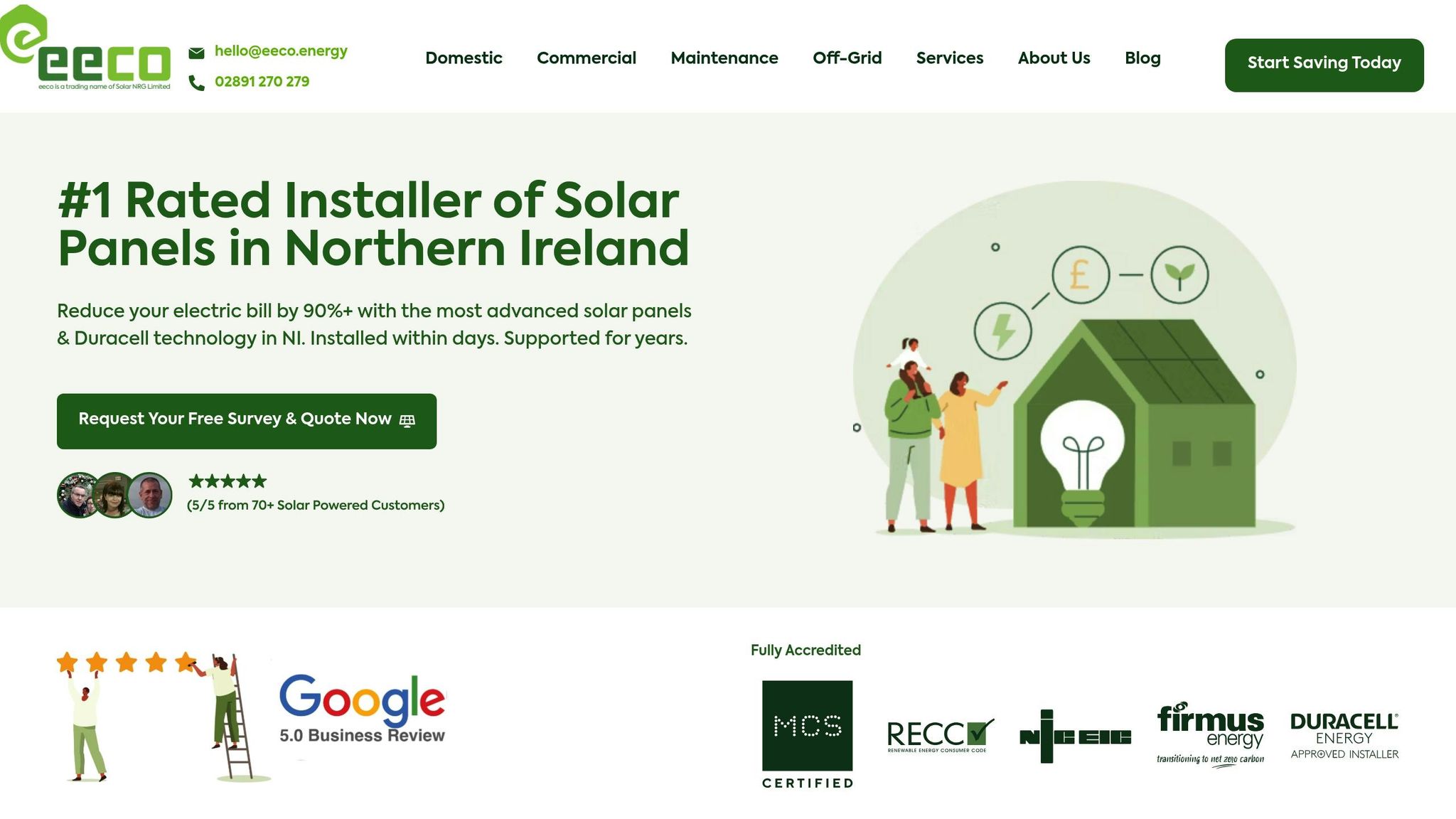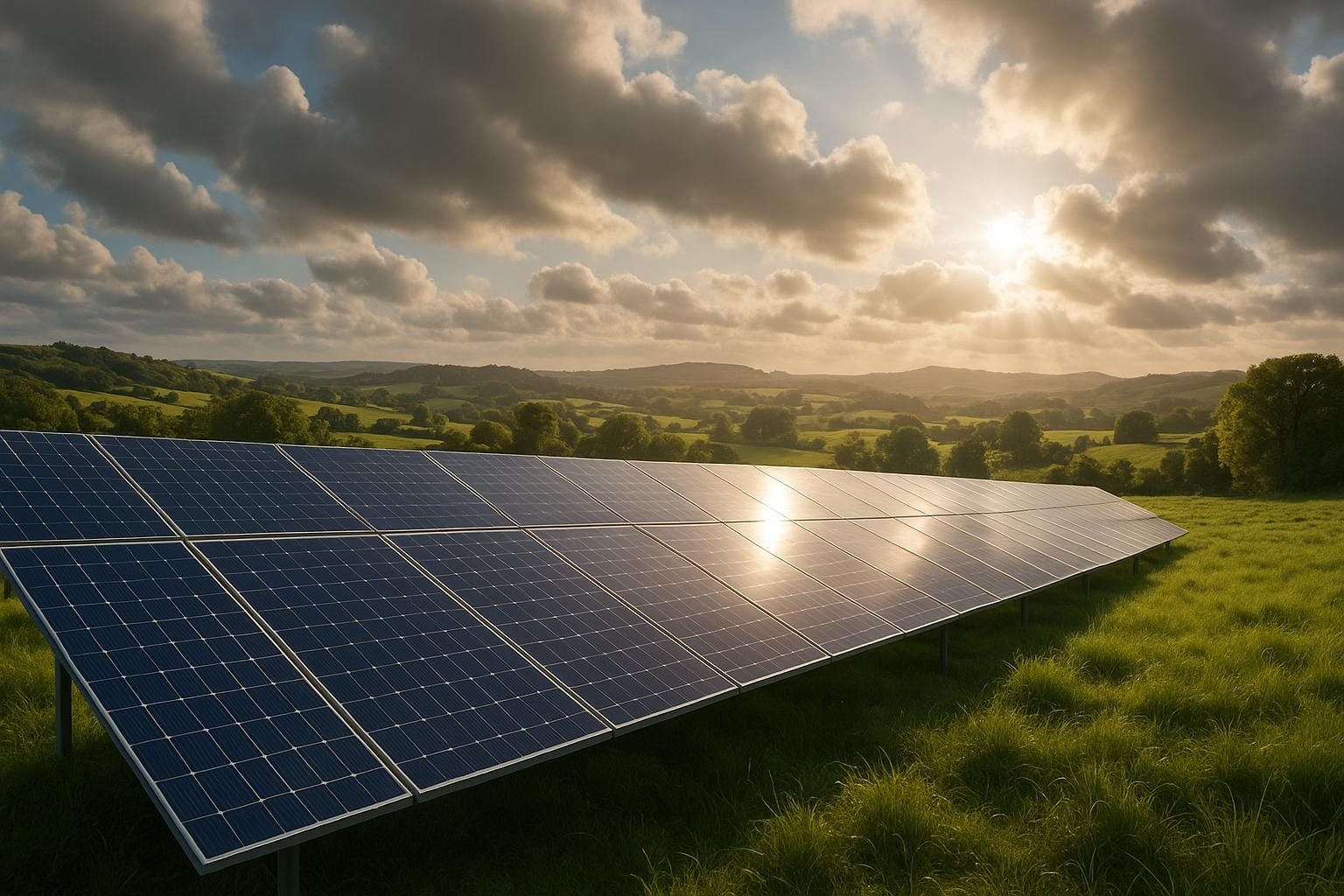Solar energy in Northern Ireland depends heavily on daylight hours, which vary significantly throughout the year. Summer days with up to 16.5 hours of daylight allow solar panels to generate 30–40% more energy compared to winter, where daylight drops to just 7 hours. This fluctuation directly affects energy output, household savings, and the efficiency of solar systems.
Key Takeaways:
- Annual Output: A standard 4kW system can produce 3,400–4,200 kWh/year, covering 60–80% of household electricity needs.
- Seasonal Variations: Summer months can generate 800–900 kWh/month, while winter drops to 150–200 kWh/month.
- Efficiency in Cloudy Weather: Modern panels work at 15–20% capacity on overcast days, ensuring consistent energy production.
- Savings Example: A household reduced their electricity bill by 90%, from £200 to £20/month, using solar power.
Boosting Solar Performance:
- Battery Storage: Store excess energy for use during evenings or winter. Savings increase by 20–50%, with systems starting at £3,650.
- High-Output Panels: Panels rated at 350–400W generate more energy, especially in low-light conditions.
- Optimal Placement: South-facing panels at a 30–40° tilt maximise output, while avoiding shading is crucial.
- Maintenance: Clean panels twice a year and monitor performance to maintain efficiency.
Northern Ireland’s mild climate and advanced solar technology make solar power a reliable choice, even with its shorter winter days and frequent cloud cover.
What Affects Solar Energy Production in Northern Ireland
Northern Ireland’s unique climate and seasonal variations play a significant role in determining solar energy production. By understanding these factors, homeowners can optimise their solar panel systems and make the most of their investment.
How Daylight Changes Throughout the Year
Seasonal shifts in daylight hours have a direct impact on solar energy output. During the summer solstice, Northern Ireland enjoys up to 16.5 hours of daylight, while winter days shrink to as few as 7 hours. This difference means that solar panels generate 30–40% more energy in summer compared to the winter months.
For example, a typical 4kW solar system can produce 800–900 kWh per month during the summer peak, but this drops significantly to just 150–200 kWh in the winter.
Real-world data highlights this variability. A semi-detached house in Bangor with a south-facing roof generated 4,100 kWh over the course of 2024 using a 10-panel system. Meanwhile, a terraced house in Derry, equipped with 6 panels, produced 2,600 kWh in the same year. Both homes exceeded their installer estimates, demonstrating that even with seasonal changes, solar systems can deliver reliable performance across Northern Ireland.
Panel Placement and Setup
The placement and positioning of solar panels are critical to their efficiency. Panels achieve optimal performance when installed at a 30–40 degree tilt and oriented south-facing. Any shading – whether from trees, buildings, or other obstructions – can significantly reduce energy output.
Orientation also matters. South-facing panels generate more electricity compared to east- or west-facing setups. Shading, however, poses a major challenge. Even a partially shaded panel can reduce the overall energy output of the entire system. This is particularly important in Northern Ireland, where winter daylight is already limited. Careful site assessments and strategic placement help mitigate shading issues, ensuring consistent energy production throughout the year.
In addition to placement, ambient temperature also influences solar panel performance.
How Temperature Affects Panel Performance
Northern Ireland’s mild climate is a surprising advantage for solar efficiency. Solar panels perform best at around 25°C, with efficiency dropping by approximately 0.5% for every degree above this temperature. Unlike hotter regions where extreme temperatures can reduce panel output, Northern Ireland’s moderate climate allows panels to maintain better efficiency year-round.
While the region receives about 1,600 hours of direct sunlight annually, less than sunnier locations, the cooler conditions prevent overheating, which can degrade performance. This balance allows solar panels to operate closer to their optimal efficiency range, contributing to reliable energy generation. It’s no surprise that over 46,000 homes and businesses in Northern Ireland now benefit from solar power.
Thanks to advancements in solar technology and a climate that favours diffuse light conditions, Northern Ireland is well-suited for solar energy. These environmental factors highlight the importance of smart strategies to maximise solar output and make renewable energy a viable option for more households.
How Daylight Hours Change Solar Energy Output
Seasonal daylight patterns in Northern Ireland have a noticeable impact on solar energy production. By understanding these shifts, homeowners can manage their expectations and plan energy usage more effectively. These seasonal variations set the stage for the changes in daily energy output explored below.
Daily Energy Output by Season
Solar panels generate energy based on available daylight, leading to significant seasonal differences in output. For instance, a 250W solar panel typically produces 0.75–1 kWh per day, but this range fluctuates throughout the year depending on the season.
Summer is the high-performance season for solar systems, with long daylight hours maximising energy production. In contrast, winter sees a sharp decline due to shorter days. For example, a semi-detached house in Bangor equipped with a 10-panel system produced 4,100 kWh annually, with the bulk of this energy generated during the summer months.
The disparity is striking: summer output can exceed winter figures by 30–40%. A solar panel that generates 1 kWh on a sunny June day might produce only 0.25 kWh on a short December day.
Despite these seasonal swings, solar systems in Northern Ireland maintain solid performance year-round. Panels in the region generate 80–85% of the output seen in southern England, demonstrating that solar remains a dependable energy source even with seasonal variations.
How Clouds and Indirect Light Affect Output
Seasonal changes aren’t the only factor influencing solar energy production – weather patterns also play a role. Northern Ireland’s often overcast skies might seem like a challenge, but modern solar panels are designed to harness energy from all types of daylight, not just direct sunlight.
Even on cloudy days, panels operate at 15–20% efficiency. Their ability to capture diffused light ensures steady, if reduced, performance. This advanced technology allows panels to convert scattered light into energy, maintaining reliability even under grey skies.
Interestingly, coastal areas in Northern Ireland enjoy a slight advantage. Light reflecting off the sea and cleaner air quality can enhance energy generation compared to inland locations. For example, a terraced house in Derry with just six panels managed to produce 2,600 kWh annually, surpassing installer expectations despite the region’s unpredictable weather.
On average, Ireland receives 4–5 hours of sunlight per day, with roughly half of this time classified as peak sun hours when solar irradiance is at its strongest. During non-peak hours or overcast conditions, panels may work at reduced efficiency but still provide consistent energy output. This reliability ensures that even in Northern Ireland’s cloudiest months, solar systems contribute meaningfully to household energy needs.
The combination of extended daylight in summer and the ability of panels to utilise indirect light allows solar systems to accumulate energy credits during brighter months. These credits help offset the lower production during the darker winter period, ensuring a steady energy supply throughout the year.
sbb-itb-d2d975a
Ways to Improve Solar Energy Production
Making the most of solar energy involves adopting practical strategies that ensure year-round efficiency. For homeowners in Northern Ireland, where winter days are shorter, these methods can significantly enhance the value of their solar systems.
Adding Battery Storage Systems
Battery storage systems can completely change how solar energy benefits your home. By storing the excess electricity generated during sunny hours, these systems allow you to use that power when it’s most needed – like in the evening, at night, or on overcast days when solar production is lower.
This approach doesn’t just improve convenience; it also boosts savings. Households with battery storage can see monthly savings increase by 20–50%, translating to lifetime savings of £20,000–£30,000 over a 25–30 year period.
"Adding a battery storage system can further increase your savings by allowing you to store excess solar energy for use during the evening or night, reducing your reliance on grid electricity and maximising self-consumption." – EECO Energy
These systems work by connecting to your inverter and storing surplus energy during daylight hours. For the average Northern Ireland household, a battery capacity of 4–8kWh is typically recommended to cover evening and overnight usage.
EECO Energy offers options tailored to local needs, including Duracell battery systems priced at £3,650 for a 10kWh capacity. Such systems are particularly effective in managing the region’s seasonal daylight variations and frequent cloudy weather.
Take, for example, a semi-detached home in Bangor. With a 10-panel solar system and battery storage, the household generated 4,100kWh in 2024, exceeding average energy needs and allowing stored energy to power the home during evenings and winter months.
Once battery storage is in place, upgrading to high-output panels can further enhance your system’s efficiency.
Selecting High-Output Panels
High-output solar panels are designed to maximise energy production, even in Northern Ireland’s moderate sunlight conditions. Rated between 350W and 400W, these panels are more efficient at converting sunlight into electricity compared to standard alternatives.
The difference is clear. For instance, a 400W panel can generate up to 1.2kWh per day under optimal summer conditions, while a 250W panel produces only 0.75kWh. This makes high-output panels especially valuable for homes with limited roof space or during winter months when every bit of sunlight counts.
Additionally, high-efficiency panels – those with a conversion rate of 20–22% – perform better in low-light conditions, which is crucial during the shorter days of winter. For example, a terraced house in Derry equipped with just six high-output panels managed to generate 2,600kWh annually, showcasing their reliability even with fewer panels.
Professional installers, like EECO Energy, evaluate factors such as roof orientation, shading, and local weather to recommend the best panels for your home. Their systems range from £3,950 for a 4.5kW system with 10 panels (producing around 3,380kWh annually) to £5,900 for a 9kW system with 20 panels, which can generate approximately 7,099kWh per year.
Even the most efficient panels, however, require regular upkeep to maintain their performance.
Keeping Panels Clean and Working Well
Routine maintenance is essential to keep solar panels operating at their best throughout their 25+ year lifespan. Clean panels ensure maximum energy production, while neglected ones can suffer performance drops that worsen over time.
With proper care, panel efficiency typically degrades by just 0.5% annually. However, dirt, bird droppings, and debris can cause more immediate declines. While Northern Ireland’s frequent rainfall helps rinse panels naturally, manual cleaning is still necessary – especially after long dry spells or storms.
For optimal performance, clean your panels twice a year and schedule an annual professional inspection. Monitoring your system’s output through smart metres or apps can help you spot any performance issues quickly. Additionally, trimming nearby trees or bushes can prevent shading and maintain consistent energy production.
The quality of installation also plays a significant role in long-term performance. Panels installed with sufficient airflow can dissipate heat more effectively, maintaining optimal operating temperatures. EECO Energy’s professional teams ensure secure mounting and correct positioning to maximise efficiency in Northern Ireland’s moderate climate.
Interestingly, during colder winter months, solar panels often perform more efficiently due to lower temperatures, which helps offset the reduced daylight hours. Combined with regular maintenance, this ensures reliable performance throughout the year, regardless of seasonal changes in sunlight.
Solar Energy Works Well in Northern Ireland
Even with its famously cloudy skies, Northern Ireland is proving to be an ideal place for solar energy. Over 46,000 homes and businesses across the region have already adopted solar panels, showing how effective this renewable energy source can be in local conditions. Let’s take a closer look at why solar power works so well here.
Key Benefits of Solar Energy in Northern Ireland
Solar panels don’t rely solely on direct sunshine – they generate electricity from daylight. This means they can still produce power on cloudy days, typically operating at 10–25% of their peak output during overcast conditions. Even in the shorter, darker days of winter, panels continue to generate electricity, though at reduced levels.
Interestingly, Northern Ireland’s moderate climate actually boosts panel efficiency. Cooler temperatures prevent the overheating that can reduce solar panel performance in warmer regions. Add to this the roughly 1,600 hours of direct sunlight the area receives annually, and you get consistent energy production and significant savings for homeowners throughout the year.
Over the typical lifespan of 25–30 years, these savings can add up to an impressive £15,000 to £25,000. With a battery storage system, those savings could increase to between £20,000 and £30,000, allowing households to store and use excess energy when it’s most needed.
EECO Energy: Tailored Solar Solutions for Northern Ireland

EECO Energy takes these benefits a step further by offering solar solutions specifically designed for Northern Ireland’s unique conditions. As certified installers of Duracell battery systems, they pair high-quality solar panels with advanced energy storage technology to maximise energy independence and financial savings.
Their expertise ensures panels are installed in the best possible locations for optimal performance, while their battery systems store surplus energy generated during the day for use in the evenings or during the winter months when sunlight is limited. This approach helps households maintain greater energy self-sufficiency, no matter the season.
EECO Energy doesn’t stop at installation. They also offer ongoing maintenance, electric vehicle (EV) charging solutions, and smart energy management systems. This all-in-one service helps customers lower their energy bills, reduce their carbon footprints, and enjoy reliable energy year-round, perfectly suited to Northern Ireland’s ever-changing weather.
FAQs
How do changes in daylight hours throughout the year affect solar panel performance in Northern Ireland?
In Northern Ireland, daylight hours shift dramatically between the seasons, which has a direct impact on how much energy solar panels produce. During the summer, the extended daylight hours lead to increased energy generation. Conversely, the shorter days of winter naturally reduce output. That said, modern solar panels are built to perform well even in low-light conditions, ensuring they provide benefits throughout the year.
When it comes to savings, solar panels can make a noticeable difference to electricity bills. Depending on factors like the size of the system, household energy consumption, and electricity rates, monthly savings can range from £50 to £180. Over the lifetime of a solar system, these savings can accumulate to anywhere between £15,000 and £25,000 or even more, offering a cost-effective way to reduce energy expenses while embracing renewable energy.
What are the advantages of adding battery storage to solar panels in areas with changing daylight, like Northern Ireland?
Adding battery storage to your solar panel system can be a game-changer, especially in places like Northern Ireland, where daylight hours shift dramatically throughout the year. By storing extra solar energy generated on sunny days, you can tap into that power later – whether it’s during the evening or on overcast days. This means you’ll rely less on electricity from the grid, which can lead to lower energy bills and long-term savings.
Beyond the financial perks, battery storage allows you to make the most of your renewable energy. It ensures a steady and dependable energy supply, even when sunlight is limited. Over time, this not only increases your energy independence but also helps create a more efficient and environmentally friendly energy setup for your home or business.
How can homeowners in Northern Ireland optimise their solar panels for maximum energy efficiency throughout the year?
To get the most out of solar panels in Northern Ireland, it’s important to install them at the right angle and direction. Ideally, they should face south and be tilted at an angle between 30° and 40° for maximum energy efficiency. Keeping the panels clean and ensuring they’re not shaded by trees, buildings, or other obstructions is just as vital.
Regular upkeep, like cleaning the panels and checking for any damage, ensures they stay in top condition. Adding a battery storage system can take things a step further. With a battery, homeowners can save the extra energy produced during the day for use later, cutting down on reliance on the grid and boosting savings. Over time, this can lead to noticeable cuts in energy bills while also helping to reduce your carbon footprint.


